- No.19 class minesweeper
-

No.29 on 22 October 1943Class overview Name: No.19 class minesweeper Builders: Kure Naval Arsenal
Fujinagata Shipyards
Harima Shipyard
Mitsubishi Heavy Industries
Tōkyō Ishikawajima ShipyardOperators:  Imperial Japanese Navy
Imperial Japanese Navy
 Soviet Navy
Soviet NavyPreceded by: No.7-class Cost: 2,660,000 JPY (in 1939) Built: 1940 – 1944 In commission: 1941 – 1945 (IJN) Planned: 70 Completed: 17 Cancelled: 53 Lost: 15 Retired: 2 General characteristics Displacement: 648 long tons (658 t) standard Length: 72.50 m (237 ft 10 in) overall Beam: 7.85 m (25 ft 9 in) Draught: 2.61 m (8 ft 7 in) Propulsion: 2 × triple expansion stages reciprocating engines
2 × Kampon mix-fired boilers
2 shafts, 3,850 shpSpeed: 20.0 knots (23.0 mph; 37.0 km/h) Range: 2,000 nmi (3,700 km) at 14 kn (16 mph; 26 km/h) Complement: 98 Armament: • 3 × 120 mm (4.7 in) L/45 naval guns
• 2 × 25 mm AA guns
• 36 × depth charges
• 1 × Type 94 depth charge projector
• 6 × paravanesThe No.19 class minesweeper (第十九号型掃海艇, Dai Jūkyū Gō-gata Sōkaitei) was a class of minesweepers of the Imperial Japanese Navy (IJN), serving during the World War II. 70 vessels were plannned under the Maru 4 Programme (Ship # 164-169), Maru Kyū Programme (Ship # 410-437) and Kai-Maru 5 Programme (Ship # 5301-5336), however, only 17 vessels were completed.
Contents
Background
- Project number I4B. Improved model of the No.7-class. The IJN gave them a turret of 55 degrees gun elevation,[1] because the IJN wanted to attack the strong point of behind the hill to them. And it was not useful in the Pacific War very much.
- And after the Maru Kyū Programme vessels abolished double-curvature bow for a mass production and changed bow shape.
Ships in class
Ship # Ship Builder Laid down Launched Completed Fate 164 Cagayan River on 10 December 1941. Decommissioned on 30 November 1945. 165 Yellow Sea 34°16′N 123°37′E / 34.267°N 123.617°E on 5 May 1945. Decommissioned on 25 May 1945. 166 Palau on 11 November 1944. Decommissioned on 10 January 1945. 168 Tsugaru Strait on 15 July 1945. Decommissioned on 10 August 1945. 410 Chichi-jima on 4 July 1944. Decommissioned on 10 September 1944. 411 Rabaul on 17 February 1944. Decommissioned on 30 April 1944. 412 Yamada 39°20′N 142°07′E / 39.333°N 142.117°E on 10 July 1945. Decommissioned on 15 September 1945. 413 Celebes Sea 01°25′N 123°29′E / 1.417°N 123.483°E on 29 August 1944. Decommissioned on 10 October 1944. 414 Shimonoseki on 7 May 1945. Decommissioned on 10 August 1945. 415 Ormoc Bay on 11 November 1944. Decommissioned on 10 January 1945. 416-417 Cancelled in 1945. 418 Onagawa Bay on 9 August 1945. Decommissioned on 15 September 1945. 419 Java Sea 06°18′S 116°14′E / 6.3°S 116.233°E on 21 May 1945. Decommissioned on 10 June 1945. 420-422 Cancelled in 1945. 423 Bashi Channel 21°21′N 119°45′E / 21.35°N 119.75°E on 19 November 1944. Decommissioned on 10 March 1945. 424 Hainan on 4 January 1945. Decommissioned on 15 September 1945. 427-437 Cancelled in 1945. 5301-5336 Cancelled in 1944. Photo
-
No.21 on 16 September 1945 at Qingdao
Footnotes
- ^ 11th Year Type 120 mm (4.7 in) naval gun, Type-M turret. No.7-class equipped the 3rd Year Type 120 mm naval gun, Type-G turret (33 degrees gun elevation).
- ^ Minesweeper No.19 (第十九号掃海艇 Dai 19 Gō Sōkaitei). The same shall apply hereinafter.
Bibliography
- "Rekishi Gunzō". http://rekigun.net/., History of Pacific War Vol.51 The truth histories of the Japanese Naval Vessels Part-2, Gakken (Japan), August 2005, ISBN 4-05-604083-4
- Ships of the World special issue Vol.45, Escort Vessels of the Imperial Japanese Navy, "Kaijinsha". http://www.ships-net.co.jp/., (Japan), February 1996
- The Maru Special, Japanese Naval Vessels No.50, Japanese minesweepers and landing ships, "Ushio Shobō". http://www.kojinsha.co.jp/. (Japan), April 1981
Japanese auxiliary ship classes of World War IICargo ships Colliers and Oilers Ōtomari S
Landing ships No.1 · No.101 · Shinshū Maru S (Army) · SS (Army)
Minelayers and Cable layer Tokiwa SC · Itsukushima S · Yaeyama S · Okinoshima S · Tsugaru S · Minoo SC · Shirataka S · Hatsutaka · Tsubame · Natsushima (1933) · Sokuten (1938) · Hirashima · Ajiro S · Kamishima · Hashima · Sokuten (1913) · Aux. No.1 · Aux. No.101 (ex-HMS Barlight) SC
Minesweepers No.1 (1923) · No.5 (1928) · No.13 · No.17 · No.7 (1938) · No.19 · No.101 (ex-HMS Taitam and Waglan) C · Aux. No.1 · Aux. No.101 (ex-HNLMS DEFG class) · Aux. No.104 (ex-HNLMS DEFG class)
Patrol boats Seaplane tenders Submarine chasers
Survey ships Target ships Training ships Fuji SC · Shikishima SC · Asama SC · Azuma SC · Kasuga SC
S - Single ship of class • C - Converted to ship type • I - Incomplete until the end of war Categories:- World War II naval ships of Japan
- Minesweepers of Japan
- Small combat vessel classes
Wikimedia Foundation. 2010.

